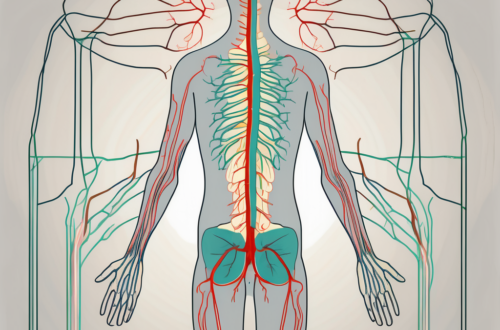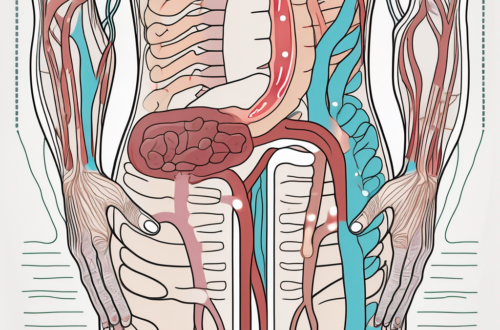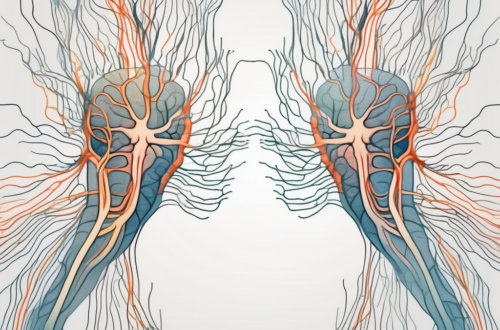The autonomic nervous system plays a crucial role in regulating various bodily functions. It is responsible for maintaining homeostasis by controlling involuntary processes such as heart rate, digestion, and respiration. The autonomic nervous system is composed of sympathetic and parasympathetic nerve fibers, each with distinct functions and effects on the body.
Introduction to the Autonomic Nervous System
Before delving into the differences between sympathetic and parasympathetic nerve fibers, let’s first understand the autonomic nervous system as a whole. This intricate network of nerves connects various organs and glands to the central nervous system, which includes the brain and spinal cord. Unlike the voluntary control we have over our skeletal muscles, the autonomic nervous system operates unconsciously, ensuring that vital processes continue to function without our conscious effort.
The autonomic nervous system plays a crucial role in maintaining homeostasis, which is the body’s ability to maintain a stable internal environment despite external changes. It constantly monitors and adjusts the body’s physiological processes to keep them within a narrow range necessary for optimal functioning.
One of the primary functions of the autonomic nervous system is to regulate the cardiovascular system. It controls heart rate, blood pressure, and blood vessel constriction or dilation. For example, when we engage in physical activity, the sympathetic division of the autonomic nervous system stimulates the heart to beat faster, increasing blood flow to the muscles and organs that need it the most.
The Role of the Autonomic Nervous System
The autonomic nervous system is responsible for regulating and maintaining internal physiological processes. It controls functions such as heart rate, blood pressure, digestion, glandular secretion, and pupillary dilation. These involuntary actions are essential for our survival and well-being.
In addition to cardiovascular regulation, the autonomic nervous system also plays a vital role in digestion. The parasympathetic division of the autonomic nervous system is responsible for stimulating the production of digestive enzymes and increasing blood flow to the digestive organs. This division promotes rest and digest activities, allowing the body to efficiently break down and absorb nutrients from the food we consume.
The autonomic nervous system also influences glandular secretion, which is the release of hormones and other substances by various glands in the body. For example, the sympathetic division can stimulate the adrenal glands to release adrenaline, a hormone that prepares the body for a fight-or-flight response in stressful situations.
Components of the Autonomic Nervous System
The autonomic nervous system consists of two main components: the sympathetic and parasympathetic divisions. Both divisions have distinct nerve fibers and serve different purposes in response to various environmental and physiological stimuli. Understanding the differences between these two systems provides valuable insights into how our bodies respond to different situations.
The sympathetic division of the autonomic nervous system is often referred to as the “fight-or-flight” system. It prepares the body for action in response to perceived threats or stressors. When activated, it increases heart rate, dilates the airways, and redirects blood flow to the muscles, enabling us to respond quickly and effectively to dangerous situations.
On the other hand, the parasympathetic division is known as the “rest and digest” system. It promotes relaxation, conserves energy, and supports activities that occur during restful periods. When activated, it slows down heart rate, constricts the airways, and increases digestive activity, allowing the body to focus on processes such as digestion, elimination, and tissue repair.
Overall, the autonomic nervous system is a complex and intricate system that plays a vital role in maintaining the body’s internal balance. Its ability to regulate various physiological processes ensures our survival and well-being in response to different environmental and physiological demands.
An In-depth Look at Sympathetic Nerve Fibers
Sympathetic nerve fibers are a part of the autonomic nervous system and are primarily responsible for the body’s “fight-or-flight” response. When faced with a threat or stressful situation, the sympathetic nervous system activates and prepares the body for action.
But what exactly happens when these sympathetic nerve fibers kick into gear? Let’s take a closer look at their function and the impact they have on the body.
Function of Sympathetic Nerve Fibers
The primary function of sympathetic nerve fibers is to mobilize the body’s resources to respond to a perceived threat or stressor. When activated, these nerve fibers trigger several physiological responses, such as increased heart rate, dilation of blood vessels, and release of stress hormones like adrenaline. These responses prepare the body to either confront the threat or flee from it.
Imagine you’re walking alone at night and suddenly hear footsteps behind you. Your sympathetic nerve fibers would immediately spring into action, causing your heart rate to skyrocket as blood vessels dilate, ensuring that oxygen-rich blood is delivered to your muscles. This surge of energy prepares you to either stand your ground or run away from the potential danger.
Impact of Sympathetic Nerve Fibers on the Body
The activation of sympathetic nerve fibers leads to a range of bodily changes that optimize our physical performance in challenging situations. These include heightened alertness, increased respiratory rate, and enhanced blood flow to major muscle groups. All of these changes are designed to give us the best chance of survival when faced with a threat.
When the sympathetic nervous system is activated, our senses become sharper, allowing us to detect even the slightest movement or sound. This heightened alertness can be a lifesaver in dangerous situations, as it enables us to react quickly and appropriately.
In addition to increased alertness, sympathetic nerve fibers also cause an increase in respiratory rate. This rapid breathing ensures that our lungs are supplied with enough oxygen to fuel our muscles during intense physical activity. It’s like a turbo boost for our respiratory system, helping us perform at our best when we need it the most.
Furthermore, the activation of sympathetic nerve fibers results in enhanced blood flow to major muscle groups. This increased blood supply delivers vital nutrients and oxygen to our muscles, improving their strength and endurance. It’s like a rush of fuel to the engine, allowing us to exert ourselves to the fullest.
However, it’s important to note that prolonged or excessive activation of the sympathetic system can have detrimental effects on our health. Chronic stress, often associated with prolonged sympathetic activation, can lead to a variety of health issues. These include elevated blood pressure, increased risk of cardiovascular diseases, and even mental health problems.
So while sympathetic nerve fibers play a crucial role in our survival, it’s essential to find a balance and ensure that our bodies have time to recover and relax after periods of intense activation. This way, we can harness the power of our sympathetic nervous system when we need it, without compromising our long-term well-being.
Exploring Parasympathetic Nerve Fibers
Parasympathetic nerve fibers, on the other hand, are responsible for the body’s “rest-and-digest” response. When we are in a relaxed state, the parasympathetic nervous system activates, enabling our bodies to conserve energy, repair tissues, and perform essential functions like digestion and elimination.
Did you know that the parasympathetic nervous system is often referred to as the “rest and digest” system? This is because when it is activated, it helps our bodies relax and focus on essential functions that promote overall well-being. Let’s dive deeper into the fascinating world of parasympathetic nerve fibers.
Function of Parasympathetic Nerve Fibers
The primary function of parasympathetic nerve fibers is to maintain basic bodily functions and restore energy reserves. When activated, these fibers reduce heart rate, constrict blood vessels, and increase gastrointestinal activity, allowing the body to divert energy towards restorative processes.
Imagine a scenario where you are sitting down to enjoy a delicious meal. As you take your first bite, your parasympathetic nervous system kicks in, signaling your body to slow down and focus on digestion. Your heart rate decreases, blood vessels constrict to redirect blood flow to the digestive organs, and your gastrointestinal activity increases to efficiently break down the food and absorb nutrients.
But that’s not all! The parasympathetic system also plays a vital role in promoting relaxation and conserving energy. It helps regulate various bodily functions, such as maintaining a healthy blood pressure, stimulating saliva production, and facilitating proper elimination.
Impact of Parasympathetic Nerve Fibers on the Body
The activation of parasympathetic nerve fibers promotes a state of relaxation and restoration. It encourages optimal digestion, absorption of nutrients, and elimination of waste. When the parasympathetic system functions optimally, it supports overall well-being and contributes to a healthy immune system.
Imagine yourself in a peaceful environment, surrounded by nature. Your parasympathetic nervous system is in full swing, allowing you to unwind and recharge. As your body relaxes, the parasympathetic nerve fibers work diligently to ensure that your digestive system is functioning at its best. This means that the food you consume is being broken down efficiently, nutrients are being absorbed effectively, and waste is being eliminated properly.
However, it’s important to note that an imbalance between sympathetic and parasympathetic activity can disrupt these processes and lead to gastrointestinal disorders and compromised overall health. Stress, for example, can trigger the sympathetic nervous system, inhibiting the parasympathetic system and interfering with digestion and other essential functions.
Understanding the intricate workings of the parasympathetic nervous system can help us appreciate the importance of relaxation and self-care. By prioritizing activities that activate our parasympathetic nerve fibers, such as meditation, deep breathing exercises, and enjoying leisurely meals, we can support our overall well-being and maintain a healthy balance between rest and activity.
Comparing Sympathetic and Parasympathetic Nerve Fibers
While sympathetic and parasympathetic nerve fibers have distinct roles and effects, they also work collaboratively to maintain balance and ensure our bodies’ optimal functioning. Let’s explore their similarities and differences.
Sympathetic and parasympathetic nerve fibers are essential components of the autonomic nervous system, which controls involuntary bodily functions. These systems operate unconsciously, meaning that we do not have to consciously think about them for them to function properly. Instead, they work automatically to regulate physiological processes and maintain homeostasis.
Both sympathetic and parasympathetic nerve fibers receive information from the central nervous system and relay signals to various organs and tissues throughout the body. This communication allows them to regulate bodily functions such as heart rate, digestion, and respiration. By working together, these systems ensure that our bodies function optimally in response to changes in the internal and external environments.
Similarities Between Sympathetic and Parasympathetic Nerve Fibers
Despite their distinct roles, sympathetic and parasympathetic nerve fibers share several similarities. Firstly, both systems are involved in maintaining homeostasis, which is the body’s ability to maintain a stable internal environment despite external changes. This means that they play a crucial role in regulating body temperature, blood pressure, and other physiological variables.
Additionally, both sympathetic and parasympathetic nerve fibers respond to changes in the internal and external environments. For example, if you encounter a stressful situation, your sympathetic nervous system will be activated, leading to an increase in heart rate, dilation of blood vessels, and the release of stress hormones like adrenaline. On the other hand, during moments of relaxation and restoration, the parasympathetic nervous system takes over, slowing down heart rate, constricting blood vessels, and promoting digestion and rest.
Differences Between Sympathetic and Parasympathetic Nerve Fibers
While sympathetic and parasympathetic nerve fibers have many similarities, they also have distinct differences in terms of their activation patterns, effects on bodily functions, and neurotransmitter release.
One key difference is their activation patterns. Sympathetic fibers are primarily activated in response to stress or emergency situations, commonly known as the “fight or flight” response. When activated, sympathetic fibers prepare the body for action by increasing heart rate, dilating blood vessels, and redirecting blood flow to the muscles. This response allows us to respond quickly and effectively to potential threats.
On the other hand, parasympathetic fibers are active during periods of relaxation and restoration, often referred to as the “rest and digest” response. When the parasympathetic system is dominant, it slows down heart rate, constricts blood vessels, and promotes digestion and rest. This state allows the body to conserve energy, repair tissues, and replenish resources.
Another difference lies in the neurotransmitters released by these nerve fibers. Sympathetic fibers primarily release noradrenaline (also known as norepinephrine) as their primary neurotransmitter. Noradrenaline helps to activate the sympathetic response and is responsible for many of the physiological changes associated with the “fight or flight” response.
In contrast, parasympathetic fibers release acetylcholine as their primary neurotransmitter. Acetylcholine has a calming effect on the body and is responsible for promoting relaxation and digestion. It helps to slow down heart rate, constrict blood vessels, and stimulate the digestive system.
In conclusion, while sympathetic and parasympathetic nerve fibers have distinct roles and effects, they work collaboratively to maintain balance and ensure our bodies’ optimal functioning. Understanding the similarities and differences between these systems allows us to appreciate the complexity of the autonomic nervous system and its vital role in regulating our bodily functions.
The Interplay Between Sympathetic and Parasympathetic Nervous Systems
The interaction and balance between sympathetic and parasympathetic activity are key to maintaining overall well-being. These two systems complement each other, ensuring that physiological processes are appropriately regulated in response to different demands and situations.
The sympathetic nervous system is responsible for the body’s “fight or flight” response, activating in times of stress or danger. It increases heart rate, dilates blood vessels, and releases stress hormones such as adrenaline. On the other hand, the parasympathetic nervous system is responsible for the body’s “rest and digest” response, promoting relaxation and conserving energy. It slows heart rate, constricts blood vessels, and enhances digestion and nutrient absorption.
Balancing Act: Sympathetic and Parasympathetic Systems
When the sympathetic and parasympathetic systems are in equilibrium, the body can effectively respond to stressors while also promoting rest and restoration. This delicate balance ensures that our bodies can adapt to different situations and maintain homeostasis.
During times of stress, the sympathetic nervous system kicks into gear, preparing the body for action. The heart beats faster, blood pressure rises, and blood flow is redirected to the muscles. This response is crucial for survival in threatening situations, allowing us to react quickly and effectively.
Once the stressor has passed, the parasympathetic nervous system takes over, promoting relaxation and recovery. It slows down heart rate, lowers blood pressure, and redirects blood flow to the digestive system. This allows the body to replenish energy stores, repair tissues, and engage in essential restorative processes.
However, disruptions in this delicate balance can have adverse effects on our health. Chronic stress, for example, can lead to a dominance of sympathetic activity, contributing to an array of physical and mental health issues. Prolonged activation of the sympathetic nervous system can lead to increased blood pressure, weakened immune function, and impaired digestion.
Effects of Imbalance Between Sympathetic and Parasympathetic Systems
An imbalance between sympathetic and parasympathetic activity can manifest in various ways. It can lead to digestive disorders, sleep disturbances, increased susceptibility to infections, and impaired immune function. For example, individuals experiencing chronic stress may develop conditions such as irritable bowel syndrome, insomnia, or frequent infections.
Furthermore, an imbalance in the autonomic nervous system can also affect mental health. Excessive sympathetic activity can contribute to anxiety, panic attacks, and difficulty concentrating, while insufficient parasympathetic activity can lead to feelings of depression, lethargy, and lack of motivation.
If you experience persistent symptoms or suspect an imbalance in your autonomic nervous system, it is essential to consult with a healthcare professional to receive proper evaluation and guidance. They can help identify the underlying causes of the imbalance and recommend appropriate interventions, such as stress management techniques, lifestyle modifications, or targeted therapies.
In conclusion, the interplay between the sympathetic and parasympathetic nervous systems is crucial for maintaining overall well-being. By understanding the delicate balance between these two systems and taking steps to support their equilibrium, we can optimize our physiological functioning and promote our overall health and wellness.
Conclusion: Understanding the Importance of Sympathetic and Parasympathetic Nerve Fibers
In conclusion, sympathetic and parasympathetic nerve fibers play vital roles in maintaining physiological balance and responding to various stimuli. While sympathetic fibers initiate the body’s response to stress, parasympathetic fibers promote relaxation and restoration. The interplay and balance between these two systems are crucial for supporting overall health and well-being. Understanding these differences can empower us to make lifestyle choices that promote a harmonious functioning of our autonomic nervous system, ensuring optimal physical and mental health.
Recap of Key Points
- The autonomic nervous system is responsible for regulating involuntary physiological processes.
- The autonomic nervous system consists of sympathetic and parasympathetic divisions.
- Sympathetic nerve fibers activate the body’s fight-or-flight response, preparing it for action.
- Parasympathetic nerve fibers promote a rest-and-digest state, conserving energy and facilitating digestion.
- Both sympathetic and parasympathetic systems play distinct roles but work together to maintain balance.
- An imbalance between sympathetic and parasympathetic activity can have adverse effects on health.
Final Thoughts on Sympathetic vs Parasympathetic Nerve Fibers
As with any medical information, it is crucial to seek professional advice and evaluation when dealing with health concerns. While understanding the differences between sympathetic and parasympathetic nerve fibers can provide valuable insights, it is essential to consult with a healthcare professional for personalized guidance. They can evaluate your specific circumstances and provide appropriate recommendations to support your overall well-being.





